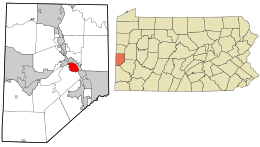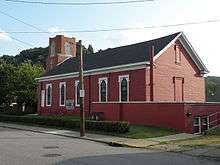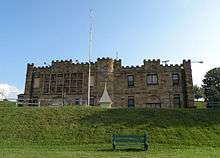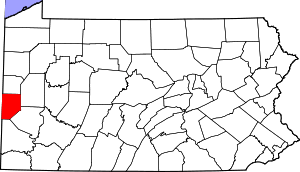Monaca, Pennsylvania
Monaca (/mɪˈnækə/ mi-NAK-ə) is a borough in Beaver County, Pennsylvania, United States along the Ohio River, 25 miles (40 km) northwest of Pittsburgh. First incorporated as Phillipsburg as the home of the New Philadelphia Society, the name of the borough was changed to Monaca in honor of the Native American Monacatootha.[3] Fire clay is found in large quantities in the vicinity, and there is an Anchor Hocking plant in the town.
Monaca, Pennsylvania | |
|---|---|
| Borough of Monaca | |
.jpg) Downtown Monaca | |
| Motto(s): "Leading the Way in Beaver County" | |
 Location in Beaver County and the U.S. state of Pennsylvania. | |
| Coordinates: 40°41′02″N 80°16′37″W | |
| Country | United States |
| State | Pennsylvania |
| County | Beaver |
| Settled | 1787 |
| Incorporated | 1840 |
| Government | |
| • Type | Borough Council |
| • Council President | Jeffery S. McKay |
| • Mayor | Simon D. Short |
| • Council members | List
|
| Area | |
| • Total | 2.38 sq mi (6.17 km2) |
| • Land | 2.03 sq mi (5.25 km2) |
| • Water | 0.35 sq mi (0.92 km2) |
| Elevation | 938 ft (286 m) |
| Population (2010) | |
| • Total | 5,737 |
| • Estimate (2019)[2] | 5,421 |
| • Density | 2,674.40/sq mi (1,032.57/km2) |
| Time zone | UTC-5 (Eastern (EST)) |
| • Summer (DST) | UTC-4 (EDT) |
| Zip code | 15061 |
| Area code(s) | 724 |
| FIPS code | 42-50320 |
| Website | www |
The population was 5,737 as of the 2010 Census.[4]
History
Early settlements

Monaca has a history dating back to the 18th century. The land on which Monaca now stands was granted by the Commonwealth of Pennsylvania by patent, bearing the date September 5, 1787, to Colonel Ephraim Blaine (1741–1804), who served in the Continental Army during the Revolutionary War, from 1778 to 1782 as commissary-general of the Northern Department,[5] and paternal great-grandfather of James G. Blaine. In the patent, this tract was called "Appetite". On August 1, 1813, the land was bought by Francis Helvidi (or Helveti, Helvedi, Helvety), described as a Polish nobleman who was exiled from his native country and immigrated to America. Helvidi, who may have been the first white settler in Monaca, bought the large "Appetite" tract and raised sheep on it, but his venture was unsuccessful. Harmony Society leader George Rapp, one of Helveti's creditors, complained in 1815 "about the risk Helvety is taking with the sheep," and in 1821, the property was sold at Sheriff's sale to Rapp.
In 1822, the beginnings of a town appeared when Stephen Phillips and John Graham purchased the property and established their "extensive boat yards" on the Ohio River there. It was first named for Phillips, and was long known as Phillipsburg.[6] Phillips and Graham built numerous steamboats, including the William Penn, which carried the Harmonites from their second settlement in New Harmony, Indiana, to Beaver County and their third and final home at Economy. In 1832, Phillips and Graham sold the entire tract of land to seceders from the Harmony Society at Economy, and moved their boat yards to what is now Freedom. The seceders from the Harmony Society were led by Bernhard Müller, known as Count de Leon. The group consisted of German immigrants who formed a communal religious society. In 1832, after leaving Economy, with about 250 former Harmony Society members, Müller and his followers started a new community in Phillipsburg (now Monaca) with the money they obtained in the settlement with the Harmony Society. Here they established the New Philadelphian Congregation, or New Philadelphia Society, constructing a church, a hotel, and other buildings. They soon renamed this community "Löwenburg" (Lion City). Perhaps because of ongoing litigation, and other financial problems, Müller's group decided to sell their communal land in Pennsylvania in 1833. Some community members stayed in Monaca, while others followed Müller and his family down the Ohio River on a flatboat. A number of the ones who followed Müller and his family eventually ended up at the Germantown Colony near Minden, Louisiana. Many stayed in Monaca, however, and not long after Müller and his followers left, a new religious speaker named William Keil showed up in the area in the early 1840s. Keil was able to attract some followers who were former Harmony Society/New Philadelphia Society members, and his group eventually moved away and settled the communal town of Bethel, Missouri, in 1844, and later settled the town of Aurora, Oregon, in 1856. Nevertheless, a number of former Harmony Society/New Philadelphia Society members stayed in Monaca, and perhaps some of their descendants live in the area to this day. In 1840, the area was incorporated as the "Borough of Phillipsburg" from the Moon Township site. The first burgess was Frederick Charles Speyerer, and the first council Edward Acker, Jacob Schaffer, Henry Jung, George Forstner, and Adam Schule.
Mid to late 1800s

Dr. Edward Acker established a "Watercure Sanatorium" in Phillipsburg in 1848, and in 1856 when the borough's first post office was established, it took the name "Water Cure". In 1865, Reverend William G. Taylor bought the Sanatorium buildings for his Soldiers' Orphans Home. The Home, according to one of the students, consisted of a "dormitory, dining room, schoolhouse, bathhouse, woodshed, carpenter shop and a two-acre playground." It burned in 1876. There is a historical marker, located near the point where Fourth Street meets Route 18, which reads: "Water Cure Sanatorium founded 1848 by Dr. Edward Acker. Used hydropathy or water to heal. First hospital in Beaver County. Town's first post office, 1856. Phillipsburg Soldiers Orphans School founded 1866 by Rev. William Taylor. Destroyed by fire 1876. Beaver County Historical Research & Landmarks Foundation".
Thiel College was founded here in 1866, and moved to Greenville five years later. There is a historical marker in town, located on Fourth Street, which reads: "Site of Thiel College endowed by A. Louis Thiel and founded in 1866 as Thiel Hall by Rev. William A. Passavant. Chartered in 1870 as Thiel College of The Evangelical Lutheran Church with Rev. Henry W. Roth as first president. Moved to Greenville, PA, 1871. Beaver County Historical Research & Landmarks Foundation".
In 1892, the name of the borough was changed from Phillipsburg to Monaca in honor of the Native American Indian Monacatootha[3] (who was also known as Scarouady). Monacatootha (which means "Great Arrow") was an Oneida warrior chief, and a representative of the Iroquois Confederacy with the authority to supervise affairs among the Delawares and Shawnees in that area.[7] Monacathootha had met with future U.S. President George Washington in Logstown. He was a strong friend of the English and campaigned against the French.
Modern era
In the borough's history, manufacturers made tons of enameled porcelain ware, glass, tile, tubing, drawn steel and wire. Today, Phoenix Glass Company/Anchor Hocking Plant #44 is located in Monaca.
In March 2012, Royal Dutch Shell announced intent to study and build a multibillion-dollar ethane cracker near Monaca to produce ethylene from abundant Marcellus shale natural gas in the area.[8] It would be the first such unit built in the northeastern United States utilizing natural gas obtained from hydraulic fracturing as feedstock. In June 2016, Shell Chemical Appalachia, LLC committed to the building of the petrochemical complex at the former Horsehead zinc site near Monaca in Potter township.[9]
Geography
Monaca is located at 40°41′2″N 80°16′37″W (40.683966, −80.276986),[10] on the south side of the Ohio River.
According to the United States Census Bureau, the borough has a total area of 2.4 square miles (6.2 km2), of which 2.0 square miles (5.3 km2) is land and 0.35 square miles (0.9 km2), or 14.89%, is water.[4]
Surrounding and adjacent neighborhoods

Monaca has only one land border with Center Township to the south and west. Across the Ohio River, Monaca runs adjacent with (from west to southeast) Beaver, Bridgewater, Rochester, East Rochester, Freedom, and Conway.
Two bridges cross the Ohio River from Monaca: the Rochester–Monaca Bridge carries Pennsylvania Route 18 into Rochester, and the Monaca – East Rochester Bridge carries Pennsylvania Route 51 into East Rochester. A third bridge, the Beaver Bridge, carries rail tracks owned by CSX Transportation from Monaca into Bridgewater.
Demographics
| Historical population | |||
|---|---|---|---|
| Census | Pop. | %± | |
| 1840 | 325 | — | |
| 1850 | 473 | 45.5% | |
| 1860 | 434 | −8.2% | |
| 1870 | 554 | 27.6% | |
| 1880 | 458 | −17.3% | |
| 1890 | 1,494 | 226.2% | |
| 1900 | 2,008 | 34.4% | |
| 1910 | 3,376 | 68.1% | |
| 1920 | 3,838 | 13.7% | |
| 1930 | 4,641 | 20.9% | |
| 1940 | 7,061 | 52.1% | |
| 1950 | 7,415 | 5.0% | |
| 1960 | 8,394 | 13.2% | |
| 1970 | 7,486 | −10.8% | |
| 1980 | 7,661 | 2.3% | |
| 1990 | 6,739 | −12.0% | |
| 2000 | 6,286 | −6.7% | |
| 2010 | 5,737 | −8.7% | |
| Est. 2019 | 5,421 | [2] | −5.5% |
| Sources:[11][12][13] | |||
As of the census[12] of 2000, there were 6,286 people, 2,709 households, and 1,741 families residing in the borough. The population density was 3,004.0 people per square mile (1,161.3/km²). There were 2,892 housing units at an average density of 1,382.1 per square mile (534.3/km²). The racial makeup of the borough was 97.1% White, 1.9% African American, 0.2% Asian, 0% from other races, and 0.7% from two or more races. Hispanic or Latino of any race were 0.6% of the population.
There were 2,709 households, out of which 26.8% had children under the age of 18 living with them, 47.6% were married couples living together, 12.7% had a female householder with no husband present, and 35.7% were non-families. 32.2% of all households were made up of individuals, and 18.8% had someone living alone who was 65 years of age or older. The average household size was 2.31 and the average family size was 2.93.
In the borough the population was spread out, with 22.0% under the age of 18, 6.8% from 18 to 24, 26.9% from 25 to 44, 23.2% from 45 to 64, and 21.1% who were 65 years of age or older. The median age was 41 years. For every 100 females, there were 87.3 males. For every 100 females age 18 and over, there were 83.4 males.
The median income for a household in the borough was $33,706, and the median income for a family was $45,046. Males had a median income of $35,436 versus $24,375 for females. The per capita income for the borough was $17,001. About 8.1% of families and 8.9% of the population were below the poverty line, including 16.7% of those under age 18 and 3.1% of those age 65 or over.
Notable people
- Brad Davis, professional basketball player
- Ed DeChellis, head coach of the Navy men's basketball team
- Dusty Drake, country music artist
- Robert Foster (American football), NFL player for the Buffalo Bills
- Mike Manzo, former chief of staff to Pennsylvania House of Representatives Majority Leader Bill DeWeese
- Joseph D. Selby, former Wyoming legislator and attorney
- Teddy Yarosz, boxing, former Middleweight Champion of the World
- Bill Zopf, NBA player for the Milwaukee Bucks
- Matt Raich, NFL Coach for the Cincinnati Bengals
John Karcis NFL player/coach. Pittsburgh Pirates, Chicago Bears, New York Giants and coach Detroit Lions.
See also
| Wikimedia Commons has media related to Monaca, Pennsylvania. |
- List of cities and towns along the Ohio River
References
- "2019 U.S. Gazetteer Files". United States Census Bureau. Retrieved July 28, 2020.
- "Population and Housing Unit Estimates". United States Census Bureau. May 24, 2020. Retrieved May 27, 2020.
- http://www.bchistory.org/beavercounty/BeaverCountyCommunities/Monaca/Monaca.html
- "Geographic Identifiers: 2010 Demographic Profile Data (G001): Monaca borough, Beaver County, Pennsylvania". U.S. Census Bureau, American Factfinder. Archived from the original on February 12, 2020. Retrieved February 24, 2014.
- "Bio of James Gillespie Blaine As found in "Representative Men of Maine" (1893), A Collection of Biographical Sketches."
- History of Beaver County, Pennsylvania and Its Centennial Celebration by Joseph Henderson Bausman (1904) Volume II, p.797
- "Archived copy". Archived from the original on May 8, 2015. Retrieved April 28, 2015.CS1 maint: archived copy as title (link)
- http://www.statejournal.com/story/17167105/shell-looks-to-pennsylvania-for-ethane-cracker
- http://www.wtae.com/news/shell-commits-to-beaver-county-ethane-cracker-plant/39935906
- "US Gazetteer files: 2010, 2000, and 1990". United States Census Bureau. February 12, 2011. Retrieved April 23, 2011.
- "Census of Population and Housing". U.S. Census Bureau. Retrieved December 11, 2013.
- "U.S. Census website". United States Census Bureau. Retrieved January 31, 2008.
- "Incorporated Places and Minor Civil Divisions Datasets: Subcounty Resident Population Estimates: April 1, 2010 to July 1, 2012". Population Estimates. U.S. Census Bureau. Archived from the original on June 17, 2013. Retrieved December 11, 2013.
